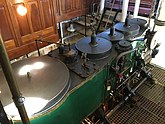Triple or multiple expansion
A triple-expansion engine is a compound engine that expands the steam in three stages, e.g. an engine with three cylinders at three different pressures. A quadruple-expansion engine expands the steam in four stages, and so on.[40] However, as explained above, the number of expansion stages defines the engine, not the number of cylinders, e.g. the RMS Titanic had four-cylinder, triple-expansion engines.[43] The first successful commercial use was an engine built at Govan in Scotland by Alexander C. Kirk for the SS Aberdeen in 1881.[44]
Multiple-expansion engine manufacture continued well into the 20th century. All 2,700 Liberty ships built by the United States during World War II were powered by triple-expansion engines, because the capacity of the US to manufacture marine steam turbines was entirely directed to the building of warships. The biggest manufacturer of triple-expansion engines during the war was the Joshua Hendy Iron Works. Toward the end of the war, turbine-powered Victory ships were manufactured in increasing numbers.[45]
A Joshua Hendy triple-expansion engine
A triple-expansion engine on the Lydia Eva (steam drifter)
A triple-expansion engine on the 1907 oceangoing tug Hercules
140-ton – also described as 135-ton – vertical triple-expansion engine of the type used to power World War II Liberty ships, assembled for testing prior to delivery. The engine is 21 feet (6.4 meters) long and 19 feet (5.8 meters) tall and was designed to operate at 76 rpm and propel a Liberty ship at about 11 kn (13 mph; 20 km/h).
https://en.wikipedia.org/wiki/Marine_steam_engine#Triple_or_multiple_expansion




No comments:
Post a Comment